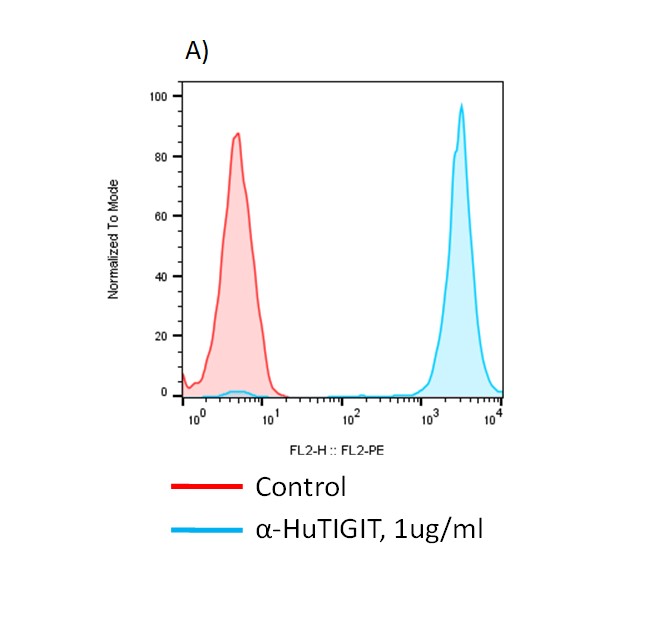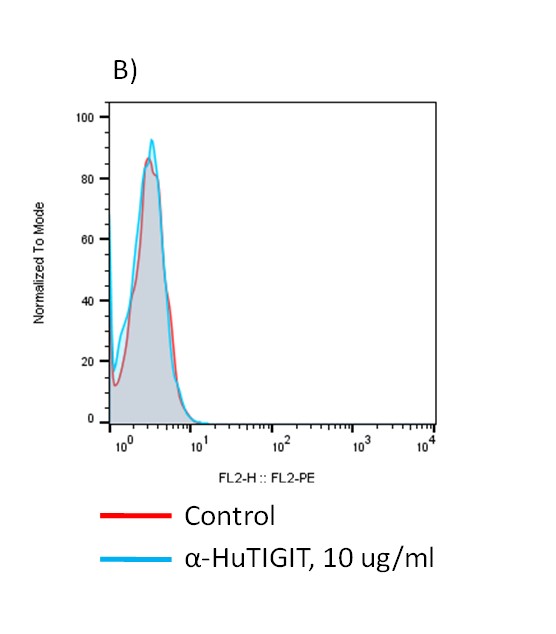
| Catalog Number | Product | Size | Price | |
|---|---|---|---|---|
| A1014-100 | Anti-human TIGIT antibody | 100µg | $185 | Order |
| A1014-200 | Anti-human TIGIT antibody | 200µg | $325 | Order |
| Catalog Number | A1014 |
|---|---|
| Product Name | Anti-human TIGIT antibody |
| Source | Recombinant anti-human TIGIT huIgG1 mAb produced from HEK293 cells |
| Clone | Tiragolumab |
| Species Reactivity | Human |
| Isotype | Human IgG1 |
| Purity | >95% |
| Formulation | 1x PBS, pH6.8. Sterile |
| Stability & Storage | 1 month at 4oC; 12 months at <-20oC; Avoid repeated freeze-thaw |
| Protein Aggregation | Not obvious on SDS-PAGE |
| Application | Flow cytometry, ELISA, cell-based assay |
| Product Datasheet: | Download PDF |
Detection of human TIGIT expression on a human TIGIT-CHO-K1 cell line (Cat. #C3020) by flow cytometry. Anti-human TIGIT huIgG1 antibody was incubated with A) human TIGIT-CHO-K1 cells (Cat. #C3020) followed by staining with PE-anti-human IgG.

B) Anti-human TIGIT huIgG1 antibody was incubated with vector control CHO-K1 cells (Cat. #C3022), followed by staining with PE-anti-human IgG.

Human T-cell immunoreceptor with Ig and ITIM domains (TIGIT) is a cell surface protein and plays a role as a crucial inhibitory immune checkpoint. TIGIT is a member of the PVR-like protein family in the immunoglobulin superfamily and is expressed on various immune cells, including CD4+ and CD8+ T cells, regulatory T cells, natural killer (NK) cells, and dendritic cells (DCs). TIGIT is expressed in various tissues, including lymphoid tissues, spleen, thymus, lung, and liver. In cancers, TIGIT expression has been observed in various solid tumors, including lung cancer, melanoma, ovarian cancer, and breast cancer. In these tumors, TIGIT expression has been associated with immune evasion and resistance to immune checkpoint blockade therapy. TIGIT binds to CD155 (PVR, Necl-5), CD112 (PVRL2, Nectin-2), and CD113, but with much higher affinity to CD155, which is expressed on dendritic cells (DCs), T cells, B cells, macrophages, endothelial cells, and tumor cells. The binding of TIGIT to its ligands results in the inhibition of T-cell activation, leading to immune suppression. Moreover, TIGIT also binds to CD226 (DNAM-1), an activating receptor that promotes T-cell activation. Due to its role in immune regulation and its expression in cancers, TIGIT has emerged as a promising therapeutic target for cancer immunotherapy.
Yu X, Harden K, Gonzalez LC, et al. Nat Immunol. 10:48-57. 2009.
Johnston RJ, Comps-Agrar L, Hackney J, et al. Cancer Cell. 26:923-937. 2014.
Harjunpää H, Guillerey C. Clin Exp Immunol. 200:108-119. 2020.
Ge Z, Peppelenbosch MP, Sprengers D, Kwekkeboom J. Front Immunol. 12:699895. 2021.